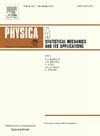考虑动态交通场景的短期车速预测方法
IF 2.8
3区 物理与天体物理
Q2 PHYSICS, MULTIDISCIPLINARY
Physica A: Statistical Mechanics and its Applications
Pub Date : 2024-10-24
DOI:10.1016/j.physa.2024.130182
引用次数: 0
摘要
车速是交通流效率和安全评估的重要指标。以往的研究通常利用目标车辆速度的时间序列数据或目标车辆与前导车辆之间的相对速度和距离作为速度预测模型的输入,这些数据适用于稳定的单车场景。然而,在车辆行驶过程中,周围的交通场景是动态变化的,驾驶员需要对周围交通场景中的关键场景车辆分配注意力,并根据这些车辆的行为调整当前车速。因此,本文提出了一种考虑动态交通场景的短时车速预测模型。采用动态网格方法将目标车辆周围区域划分为左前方、前方和右前方区域。并根据每个区域的状态识别关键场景车辆。然后选择目标车辆与关键场景车辆之间的相对距离、速度和加速度数据作为模型输入。利用合肥南北一号高速公路的车辆轨迹数据和游侠优化的时序卷积网络(TCN)来训练速度预测模型。实验结果表明,在 1 秒、2 秒和 3 秒的预测长度下,模型的平均均方根误差(RMSE)和平均绝对误差(MAE)分别为 0.430 和 0.271。与考虑静态交通场景的速度预测模型相比,三种预测长度的平均均方根误差(RMSE)和平均绝对误差(MAE)分别降低了 49.15 % 和 56.02 %。本文章由计算机程序翻译,如有差异,请以英文原文为准。
A short-term vehicle speed prediction approach considering dynamic traffic scene
Vehicle speed serves as a crucial indicator in traffic flow efficiency and safety evaluation. Previous researches typically utilize the time-series data of target vehicle speed or the relative speed and distance between the target and leading vehicles as speed prediction model input, which are suitable for stable and single-vehicle scenes. However, the surrounding traffic scenes dynamically changes during the vehicle’s driving process, the driver needs to allocate attention to the key scene vehicles in the surrounding traffic scenes and adjust the current speed based on these vehicles’ behavior. Therefore, this paper proposes a short-time vehicle speed prediction model considering the dynamic traffic scenes. A dynamic grid method is adopted to divide the target vehicle’s surrounding areas into left front, front, and right front regions. And key scene vehicles are identified based on each region’s state. Then the relative distance, speed, and acceleration data between the target vehicle and key scene vehicles are selected as model inputs. Vehicle trajectory data from the South-North No. 1 Expressway in Hefei and Ranger optimized Temporal Convolutional Network (TCN) are utilized to train the speed prediction model. Experiment results indicated that under 1 s, 2 s, and 3 s prediction lengths, the model’s average Root Mean Square Error (RMSE) and Mean Absolute Error (MAE) were 0.430 and 0.271 respectively. Compared to the speed prediction model considering the static traffic scenes, the average RMSE and MAE for the three prediction lengths have been reduced by 49.15 % and 56.02 % respectively.
求助全文
通过发布文献求助,成功后即可免费获取论文全文。
去求助
来源期刊
CiteScore
7.20
自引率
9.10%
发文量
852
审稿时长
6.6 months
期刊介绍:
Physica A: Statistical Mechanics and its Applications
Recognized by the European Physical Society
Physica A publishes research in the field of statistical mechanics and its applications.
Statistical mechanics sets out to explain the behaviour of macroscopic systems by studying the statistical properties of their microscopic constituents.
Applications of the techniques of statistical mechanics are widespread, and include: applications to physical systems such as solids, liquids and gases; applications to chemical and biological systems (colloids, interfaces, complex fluids, polymers and biopolymers, cell physics); and other interdisciplinary applications to for instance biological, economical and sociological systems.

 求助内容:
求助内容: 应助结果提醒方式:
应助结果提醒方式:


